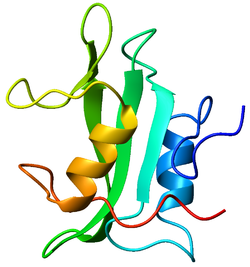This article needs additional citations for verification. (April 2012) |
Tyrosin-protein kinase Lck (or lymphocyte-specific protein tyrosine kinase) is a 56 kDa protein that is found inside lymphocytes and encoded in the human by the LCK gene.[5] The Lck is a member of Src kinase family (SFK) and is important for the activation of T-cell receptor (TCR) signaling in both naive T cells and effector T cells. The role of Lck is less prominent in the activation or in the maintenance of memory CD8 T cells in comparison to CD4 T cells. In addition, the constitutive activity of the mouse Lck homolog varies among memory T cell subsets. It seems that in mice, in the effector memory T cell (TEM) population, more than 50% of Lck is present in a constitutively active conformation, whereas less than 20% of Lck is present as active form in central memory T cells. These differences are due to differential regulation by SH2 domain–containing phosphatase-1 (Shp-1) and C-terminal Src kinase.[6]
Lck is responsible for the initiation of the TCR signaling cascade inside the cell by phosphorylating immunoreceptor tyrosine-based activation motifs (ITAM) within the TCR-associated chains.
Lck can be found in different forms in immune cells: free in the cytosol or bound to the plasma membrane (PM) through myristoylation and palmitoylation. Due to the presence of the conserved CxxC motif (C20 and C23) in the zinc clasp structure, Lck is able to bind the cell surface coreceptors CD8 and\or CD4.
Bound and free Lck have different properties: free Lck has more pronounced kinase activity in comparison to bound Lck, and moreover, the free form produces a higher level of T cell activation.[7] The reasons for these differences are not well understood yet.
- ^ a b c GRCh38: Ensembl release 89: ENSG00000182866 – Ensembl, May 2017
- ^ a b c GRCm38: Ensembl release 89: ENSMUSG00000000409 – Ensembl, May 2017
- ^ "Human PubMed Reference:". National Center for Biotechnology Information, U.S. National Library of Medicine.
- ^ "Mouse PubMed Reference:". National Center for Biotechnology Information, U.S. National Library of Medicine.
- ^ "UniProt". www.uniprot.org. Retrieved 11 May 2024.
- ^ Moogk D, Zhong S, Yu Z, Liadi I, Rittase W, Fang V, et al. (July 2016). "Constitutive Lck Activity Drives Sensitivity Differences between CD8+ Memory T Cell Subsets". Journal of Immunology. 197 (2): 644–654. doi:10.4049/jimmunol.1600178. PMC 4935560. PMID 27271569.
- ^ Wei Q, Brzostek J, Sankaran S, Casas J, Hew LS, Yap J, et al. (July 2020). "Lck bound to coreceptor is less active than free Lck". Proceedings of the National Academy of Sciences of the United States of America. 117 (27): 15809–15817. Bibcode:2020PNAS..11715809W. doi:10.1073/pnas.1913334117. PMC 7355011. PMID 32571924.






